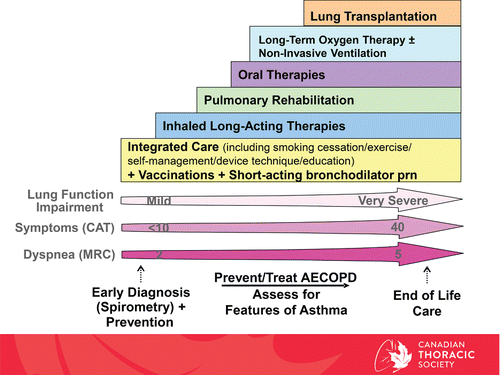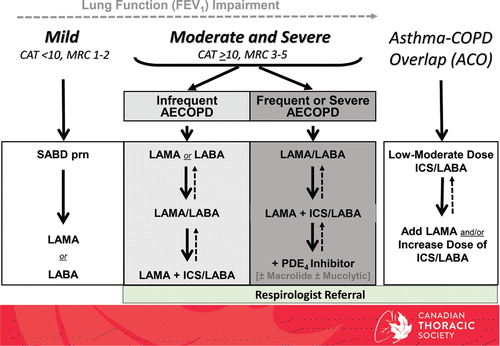Figures & data
Figure 1. Comprehensive Management of COPD. Integrated approach of care that includes COPD diagnosis with spirometry, evaluation of symptom burden and risk for future exacerbations with on-going monitoring, assessment for features of asthma, and comprehensive management, both non pharmacologic and pharmacologic. CAT = COPD assessment test; MRC = Medical Research Council; SABD PRN = short-acting bronchodilator as needed; AECOPD = acute exacerbation of COPD; Inhaled Long-Acting Therapies = long-acting muscarinic antagonist and/or long-acting B2-agonist and/or inhaled corticosteroid; LTOT = long-term oxygen therapy.

Table 1. CTS COPD Position Statement PICO questions.
Table 2. Literature search results informing recommendations.
Figure 2. COPD Pharmacotherapy. Suggested COPD pharmacotherapy promoting an approach that matches treatment decisions with symptom burden and risk of future exacerbations. Solid arrows indicate step up therapy to optimally manage symptoms of dyspnea and/or activity limitation, as well as the prevention of AECOPD where appropriate. Dashed arrows indicate potential step down of therapy, with caution, and with close monitoring of the patient symptoms, exacerbations and lung function. Frequent AECOPD is ≥2 events requiring antibiotics ± systemic corticosteroids over 2 years; or ≥1 Severe AECOPD requiring hospitalization. As-needed (prn) use of short-acting bronchodilator should accompany all recommended therapies. CAT = COPD assessment test; MRC = Medical Research Council; SABD prn = short-acting bronchodilator as needed; AECOPD = acute exacerbation of COPD; LAMA = long-acting muscarinic antagonist; LABA = long-acting B2-agonists; ICS = inhaled corticosteroid; PDE4 = phosphodiesterase-4.

Table 3. Proposed assessment and diagnostic criteria of patients suspected of having ACO.
